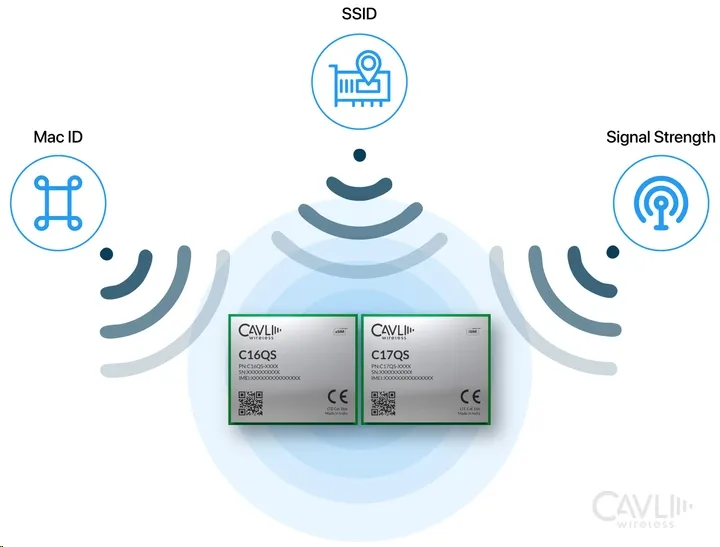The Internet of Things (IoT) is transforming industries with automation, efficiency, and data-driven insights. Seamless connectivity and precise location awareness are critical for unlocking this potential, especially in indoor environments where cellular networks and GPS often fall short. Cavli’s upgraded LTE Cat 1bis modules, the C16QS and C17QS, introduce powerful WiFi scanning capabilities, offering a cost-effective, energy-efficient solution for IoT applications. This blog explores how these modules enhance IoT deployments, their technical features, and their practical benefits for developers and end users.
Why Choose C16QS and C17QS for IoT Connectivity?
Cavli’s C16QS and C17QS modules, built on the Qualcomm QCX217 chipset, combine robust LTE Cat 1bis connectivity with advanced WiFi scanning, making them ideal for low-power wide-area network (LPWAN) applications. By leveraging ubiquitous WiFi networks, these modules provide location accuracy in GPS-denied environments, reducing reliance on power-intensive GPS. This innovation, backed by Cavli’s expertise in IoT connectivity, streamlines development and enhances operational efficiency.
Key Features of C16QS and C17QS Cellular IoT Modules
C16QS:
Processor: Cortex M3 up to 204Hz.
Memory: 1.25MB RAM, 4MB Flash.
Connectivity: Integrated eSIM for seamless cellular access.
Location: L1 GNSS for basic location services.
Use Case: Cost-sensitive deployments requiring reliable connectivity and fundamental location awareness.
C17QS:
Processor: Cortex M3 up to 306Hz.
Memory: 2MB RAM, 8MB Flash.
Connectivity: iSIM support (under development).
Location: Advanced multi-constellation GNSS (L1+L5) for superior accuracy.
Use Case: High-performance applications prioritizing location precision.
These modules, powered by Qualcomm’s proven QCX217 chipset (Qualcomm IoT Solutions), deliver reliable performance for diverse IoT needs.
Understanding WiFi Scanning in IoT Modules

WiFi scanning enables IoT devices to passively listen for beacon frames from WiFi access points, capturing data like SSID and signal strength. By triangulating signals from multiple access points, the C16QS and C17QS estimate a device’s location, offering a power-efficient alternative to GPS in indoor or urban environments. This capability, detailed in Cavli’s technical documentation, is ideal for battery-powered devices, ensuring long operational life without sacrificing location accuracy.
Benefits of WiFi Scanning:
Indoor Location Accuracy:
Effective in GPS-denied environments like warehouses or hospitals.
Energy Efficiency:
Consumes less power than GPS, extending device battery life.
Cost-Effective:
Utilizes existing WiFi infrastructure, reducing deployment costs.
Engineering Implications for OEMs
Integrating WiFi scanning into the C16QS and C17QS simplifies hardware design for OEMs. By eliminating the need for separate WiFi chipsets, these modules reduce Bill of Materials (BOM) costs, minimize power consumption, and streamline development. OEMs can leverage pre-existing WiFi access points in environments like warehouses, bypassing the need for dedicated indoor positioning systems (e.g., Ultra-Wideband or Bluetooth beacons).
Example Use Case: Smart Logistics Tracking
For a logistics tracking solution, OEMs can use the C16QS or C17QS to enable indoor tracking without additional hardware. The modules passively collect WiFi data, enabling real-time location updates in warehouses or distribution centers. This reduces deployment complexity, accelerates market entry, and lowers costs, as validated by Cavli’s case studies in IoT logistics.
Technical Advantages:
Simplified Integration:
No additional transceivers or antennas required.
Reduced BOM Costs:
Built-in WiFi scanning lowers hardware expenses.
Faster Development:
Accessible WiFi data simplifies location-based service development.
Practical Implications for End Users

WiFi scanning enhances end-user efficiency in real-world scenarios. In a warehouse, the C16QS or C17QS tracks high-value assets through packaging, palletizing, and staging by detecting proximity to WiFi routers. This data integrates with warehouse management systems, providing real-time insights into inventory movement, reducing manual tracking, and optimizing operations.
Real-World Example: Warehouse Asset Tracking
A high-value package equipped with a C16QS module moves through a warehouse. As it passes WiFi access points, the module registers its location, updating the management system instantly. This improves inventory accuracy, speeds up order fulfillment, and enhances customer satisfaction. Similar applications apply to manufacturing plants or hospitals, where operational visibility is critical.
End-User Benefits:
Real-Time Tracking:
Granular location data improves asset management.
Operational Efficiency:
Automates tracking, reducing human intervention.
Versatility:
Applicable across industries like logistics, healthcare, and manufacturing.
Conclusion: The Future of Location-Aware IoT
Cavli’s C16QS and C17QS modules, with integrated WiFi scanning, empower developers to create cost-effective, location-aware IoT solutions. By simplifying hardware design, reducing costs, and enabling precise indoor tracking, these modules unlock new possibilities for industries like logistics, healthcare, and manufacturing. As IoT evolves, Cavli remains committed to delivering innovative connectivity solutions, backed by our expertise and Qualcomm’s reliable technology, to drive the connected world forward.
Go Beyond and Explore
Does the C16QS and C17QS support WiFi scanning?
Yes, both the C16QS and C17QS modules are equipped with WiFi scanning capabilities. This feature enables the modules to detect and utilize WiFi networks for enhanced location accuracy, making them ideal for IoT deployments in environments where GPS connectivity is limited or non-existent.
Can WiFi scanning in C16QS and C17QS replace GPS for location tracking?
While WiFi scanning provides a valuable complement to GPS by offering location data in areas where GPS is unreliable, it does not replace GPS entirely. It serves as a supplementary method that enhances location accuracy and reliability, particularly in indoor settings.
What are the benefits of integrating WiFi scanning in IoT devices using C16QS and C17QS modules?
Integrating WiFi scanning in IoT devices using these modules simplifies the device architecture by reducing the need for additional hardware, lowers power consumption, and enhances the overall efficiency of the system. It allows for more precise and reliable location tracking and enables developers to build more sophisticated, location-aware applications.
Are there any specific applications that benefit the most from the WiFi scanning feature in C16QS and C17QS modules?
Yes, applications such as smart warehousing, asset tracking, and indoor navigation systems benefit immensely from the WiFi scanning capabilities of the C16QS and C17QS modules. These applications require precise location tracking that GPS alone cannot provide, especially in enclosed spaces like warehouses and large buildings.


